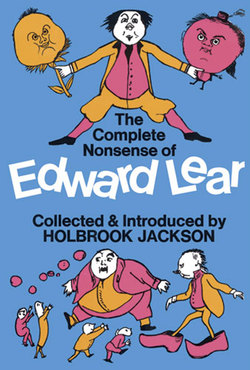Читать книгу The Complete Nonsense of Edward Lear - Edward Lear - Страница 7
На сайте Литреса книга снята с продажи.
1
ОглавлениеJust over a hundred years ago the children of England (and also many older folk) were surprised into entertainment by the appearance ‘out of the blue’ of an oblong book of hilarious rhymes and still more hilarious pictures by an author hitherto unknown to the general public. This fantastic collection of rhymes-without-reason was an instantaneous success, and Edward Lear’s Book of Nonsense had given a local habitation and a name to one of the oldest and most persistent of human faculties. Its author, like an earlier poet, awoke to find himself famous—but in an entirely different branch of art from that by which he sought to earn a living, and he remains its unchallenged laureate. The literature of nonsense has grown in quality as well as quantity during the past century but the whole-hearted abandonment of sense, as formalised by Edward Lear, is still the classical example of this curious and amusing art.
There are several ways of approaching the fine arts and particularly that of an artist so peculiar as Edward Lear, for although the entertainment value of the Book of Nonsense and its pendants is obvious, the personality and motives behind that work will repay examination. Such an examination is tempting because Lear was no ordinary writer turning out humorous books for a living, nor were those books his only productions; on the contrary his nonsense began as the sideline of a professional life devoted to the illustration of books, mainly ornithological, and the pursuit of the picturesque for those landscapes which were latterly his main source of revenue. At the same time nonsense was not merely an occasional, still less an idle occupation. What appeared to begin and end in the casual amusement of children was actually a method of amusing, or, better, diverting himself. His excursions into the realm of nonsense were certainly occasional but the occasions were so frequent as to pervade the whole of his life, ultimately becoming a continuous as well as a formal medium of expression. Nonsense was the safety-valve of his consciousness responding to most of his approaches to himself and his environment. It became ultimately a world in itself specially created by him as a refuge from the trials and irritations of life: ill-health, lack of means, and, above all, an over-strung sensibility. Nonsense was thus Lear’s Ivory Tower and it was far more accessible than most retreats of the kind and its peace could be enjoyed without fuss or ceremony in most emergencies. It was as though he lived a double life, one in the realm of sense and the other in that of nonsense; and he had the power of transmuting himself from one to the other at will, a gift which he exercised almost continuously as his familiar letters prove. Most of those who know the Book of Nonsense and even one or more of the sequels think of Lear solely as writer and illustrator of amusing limericks; but that was only one form of his nonsense. In addition and equally important are his nonsense alphabets and vocabularies, poems and pictures, which comprise nonsense geography, natural history, botany, and anthropology. He depended largely upon his own subconscious promptings for the flora and fauna of this funny cosmogony, but was not averse from annexing birds and animals from nature which happened to approximate to his own nonsensical conceptions. Thus pelicans and parrots, seals and rhinoceroses and other queer creatures associated appropriately with his Dongs and Pobbles and Quangle-Wangles:
Herons and Gulls and Cormorants black
Cranes and Flamingoes with scarlet back,
Plovers and Storks, and Geese in clouds,
Swans and Dilberry Ducks in crowds.
He even nonsensified himself and his cat in verse, and in those humorous drawings which are a characteristic and happy feature of a large number of his letters to intimate friends.
